Quick-and-dirty summary of the past week: Moderate, fickle winds shifting directions on a regular basis; some rain and cloud cover, but nothing too bad; more whale-watching boats on the water this week than the previous week; fewer tourists and less yacht traffic viz the average for this time of year; lots and lots of baby humpback whales; more breaching activity than I’ve seen in several years.
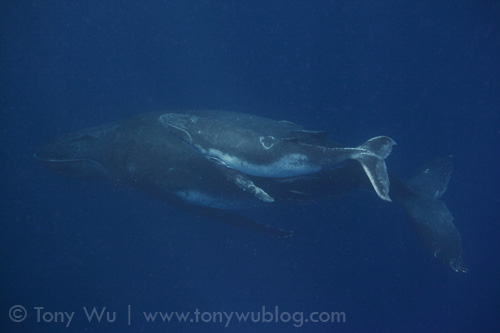
Fitu (calf #7 of the 2011 season) with mom.
Note the unusual clover-like mark on the calf's dorsal surface.
Dirty Dozen
The big news of the week is that our mother/ calf ID count is up to 12 pairs now. That’s triple the number I ended last week with, and double to quadruple the figure at this same time in the past few years.
As you can see from the graph below (which I excerpted from my 2010 humpback whale calf count summary file), we’re on track to surpass the 2009 count of 31 mother/ calf pairs. I’m hoping to end the season with at least 32.
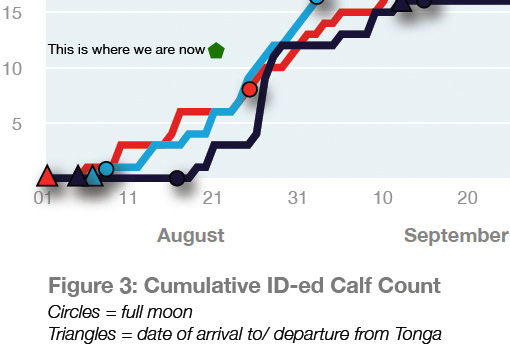
Our calf ID count is proceeding at a record pace this season.
(2008 = black, 2009 = blue, 2010 = red)
Hitting 32 would be great. It would be satisfying to achieve a record calf count this year, as I set out a case for the possibility of a banner baby year this season when I wrapped up in 2010. But more importantly, surpassing our 31-calf count in 2009 would be a positive indication for the health and recovery of the southern hemisphere humpback whale population...which is, after all, the most important thing.
I know there are more babies around, but it’s simply not possible to get to every calf that’s spotted each day. Plus, we are confined to land for seven Sundays this season due to the restrictions on tourism in Vava’u, meaning I’m losing a week’s worth of working time.
Reinforcements have arrived though. My friends Shawn and John just got here to continue filming for a documentary project (they were here last season too), so I’ll have more eyes on the water for the next couple of weeks.
Having an extra boat out on the water with reliable, competent people will be invaluable.
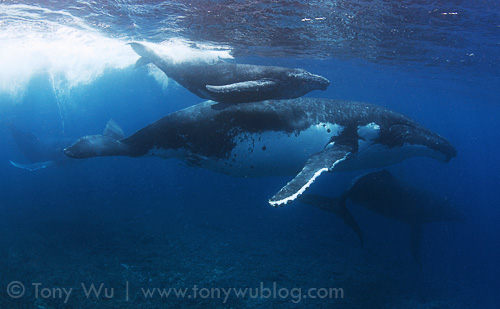
Lima (calf #5 of the 2011 season) and mom with two escorts, travelling at high speed
There are a few things I think worth mentioning at this stage about our calf sightings.
First, many of our encounters this season have been in murky water, with really bad visibility. This makes ID-ing even more challenging, as we need to be able to make out unique features on the mother/ calf pairs to be confident about the IDs.
To complicate matters, quite a few of the moms have seemed particularly shy. It’s normal for some proportion of the female humpbacks we encounter to be evasive, but subjectively, there seems to be a high ratio this year.
The practical implication of bad visibility + shy moms for my ID effort is that for quite a few mother/ calf pairs, we only have a few shots...from behind, at a distance, in murky water. Certainly not ideal, but fortunately, still workable...with lots of squinting and hand-wringing.
Another implication is that it’s been more difficult than in previous seasons to determine the sex of the baby whales we’ve seen. In order to sex the little ones, I need to be able to see/ photograph their undersides, which means being reasonably close and having time to observe. So far, I’ve only been able to determine the sex of three of the 12 babies: two males and one female.
Finally, there have been people who’ve argued over the years that there are few/ no baby whales in the inner island areas, especially in places with frequent boat traffic. This argument has been used as attempted justification to create restrictions on boat traffic and/ or to ban whale watching/ whale swimming.
Over the past couple of seasons, we’ve used GPS to mark our calf encounters, and have demonstrated that humpback whale mother/ calf pairs make use of all the waters around Vava’u, including the inner waterways.
This season is shaping up the same way. This past week, for example, we’ve come across mother/ calf pairs next to Luamoko, by Tungasika, near Matamaka, and off of Oto.
I’m certainly not saying that boats and people don’t need to be careful in the inner waterways, but I am saying that discussion of this nature need to be resolved based on fact, not emotional fervour.

Sunset in Vava'u on Wednesday.
Red skies at night were a good sign for the following day.
Sex Change
I made a mistake last week.
Tolu (calf #3) is not female. She is now a he; or more accurately, he was never a she.
I’m not sure how I made that mistake, but it’s probably because my days are so packed, and I’m doing all my file downloading, GPS recording, note-taking and calf ID-ing at night, when I’m just bloody exhausted.
Anyway, I caught the mistake because we had a third encounter with Tolu this week, meaning that Tolu and mom have been in Vava’u for at least eight days (first encounter on 11 Aug, second on 13 Aug, most recent on 18 Aug).
Tolu’s mom was quite shy during our first two encounters, making it difficult to get really good photos. Tolu, if you recall, is an extremely playful calf that reminded me of Ikumi from last year, with a wound on his abdomen that looks like it resulted from an unfortunate encounter with a fishing line or other similar rope.
Anyway, in this third encounter, Tolu and mom were accompanied by an escort. In many instances, escorts stir things up. They often push the mom and baby along, keeping the whales moving and making it relatively difficult to have good encounters. This was the case with Lima, calf #5, which was accompanied by two escorts, as well as for Fitu (calf #7) and Valu (calf #8) which were both travelling at high speed with escorts.
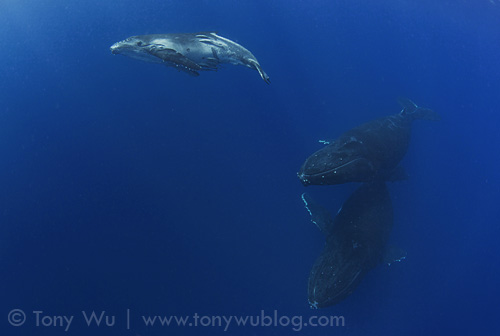
Little Tolu being allowed to go off and play on his own,
while mom and escort make like lovebirds below
In this case, the escort seemed to have a calming effect on Tolu’s mom. She was relaxed, chilled out, totally unconcerned with where her baby was playing. She let Tolu tail-slap and flop around at the surface alone, head over to play with people, and generally do as he pleased...while she and the escort cruised along, often touching one another, in what appeared to be lovey-dovey bliss. Complete contrast to the first two encounters.
I write that half tongue-in-cheek, but that’s really what it seemed like. Tolu’s mom must have really, really liked this particular escort. His presence completely pacified her.
The upshot was that Tolu was allowed to play with us, and I was able to take really good photos of his abdomen, showing that Tolu is a definitely a he.
[Note: In case you’re not familiar with the concept of an escort whale, it’s basically a horny male that’s hanging out with a female with a kid already, perhaps in hopes of getting some action.]

Humpback whale calf Tolu playing at the surface,
while mom (right) and escort cruise together below
For comparison, here is photo of Tahataha (calf #11), showing her developing mammary slits. Boys like Tolu don’t have those.
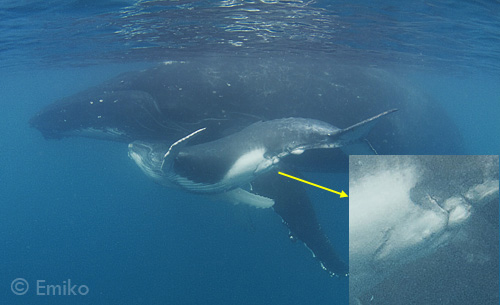
Tahataha (calf #11 of the 2011 season) with mom,
in extremely bad visibility. Inset shows the calf's mammary slits
The Week Ahead
For the upcoming week, friends from Japan, the US and Singapore are here with me. We’ll be out on three boats looking for great encounters, and hoping to add to the calf count if weather, winds, water and whales permit.
I’m also hoping that in addition to mother/ calf pairs, we’ll see some high-action heat runs and more breaching. Swimming with mother/ calf pairs is wonderful, but there’s nothing quite like the adrenaline rush of watching a bunch of whales travel at high speed while snorting, groaning, slapping and body-slamming one another!